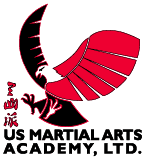Martial Arts Training Benefits
There are many benefits to training in martial arts. Training provides opportunities to exercise and improve various aspects of an individual.
Physical Benefits of Martial Arts Training
Many people consider the practice of a martial art much like the practice of any other sport. In some ways, martial arts training is like training in football, soccer, lacrosse, etc. When someone regularly practices any sport, there are physical benefits to be gained. Cardio fitness (lung capacity and heart efficiency), strength, target accuracy, and agility improve. All of this occurs in martial arts training, too.
In most sports, a player's handedness (right or left hand dominance) determines whether the player uses the primarily dominant hand or foot to catch, hit, or kick a ball, but martial artists train to use both the right and left hands and feet. Advanced students learn to wield weapons with both hands, often in synchronous motion.
Over time, the student's agility, balance, coordination, and strength improves which then produces more graceful movement. Many advanced practitioners of martial arts develop graceful fighting techniques as this graceful movement is a result of the most efficient use of muscle strength, coordination, and speed combined with exceptional balance. There is no wasted motion.
Mental Benefits of Martial Arts Training
Many martial arts also teach choreographed fighting patterns (forms, katas, etc.) and other finely detailed techniques. This training requires accurate observation and the ability to memorize long sequences. This training occurs gradually -- beginning students learn much shorter forms than more advanced students. Over time, the practitioner will learn many forms, each progressively more complicated. The individual movements will also progress in difficulty -- simple kicks will eventually lead to spinning kicks, and later jumping spinning kicks. This training improves the ability to notice and learn fine, intricate details. The ability to memorize improves.
As part of defensive training, students are taught to observe their surroundings as well as people in their path. Training will include practice in reading a person's subtle body movements to determine which side of the body will initiate an attack and how to best counter the attack. With repeated practice and time, this awareness can become instinctual.
Social and Behavioral Benefits of Martial Arts Training
Martial arts students practice defensive behavior in attack scenarios. Even the youngest students train in methods to escape an aggressor and deflect or defend themselves from attack. Students are taught to differentiate between aggression from a bully and an attack from a malevolent stranger and respond appropriately. With repetition and practice, the student's response should become instinctive. Students with these defensive skills are more confident in themselves.
Due to the need to have unhindered movement, martial arts clothing is loose-fitting with no metal or hard surfaces such as buttons or zippers. It is designed for maximum motion, safety, and comfort. All students dress similarly in baggy, fairly shapeless clothing. The student will not be expected to have a particular "good" body type, shape, or weight level as may be the case in aesthetic sports such as gymnastics, cheer-leading, figure skating, or in any dance program. Negative body image is not an issue in martial arts.
Students practice their punches, kicks, etc., on stationary equipment and older students will also partner with another student. Honor, trust, and respect is required of the students to practice offensive and defensive moves in partner drills and safely engage with each other. Also to train effectively, students must work with good effort to motivate each other and to improve their abilities.
Advancement is not measured against the group. Each student sets the pace of advancement based on individual goals and training criteria. While students can also participate in competitive events, the outcome of the competition does not affect a student's training, except where most students tend to train more consistently when working toward a short-term goal such as performing well in competition. It is this increased training in preparation for competition that adds to the overall improvement in skills for the student. Any win or medal in competition is pleasant and appreciated, but is incidental to the improvement of the individual.
For some individuals who do not benefit from participating in team sports (either from shyness, incoordination, etc.) martial arts seems to provide an activity that both fun and enriching. Students can see improvements in their individual abilities while enjoying the camaraderie of training with others.
Lifelong Benefits of Martial Arts Training
These new skills will help students of martial arts in other endeavors, including other sports. Parents have reported that they have noticed an improvement in their child's abilities in other sports and in school. They are more alert, quicker to respond, stronger, more coordinated, more disciplined, more confident and are less fatigued while participating in other activities.
Some people will use the study of martial arts as a new sport to be practiced for a season. This is fine, but the benefits of martial arts are compounded by the length of time spent training. While a short length of training will improve the student's overall abilities, it is nothing compared to the improvement realized with years of training. Much of the real, lifelong skills are developed gradually, where muscle memory, muscular coordination, reaction time, alertness, and instinct improve incrementally over long periods of time. The less easily measured virtues of honor, respect, confidence, and self-esteem are also nurtured and improved through martial arts training.
Training Future Generations of Martial Artists
We have students that began as children, Kung Fu Kids, who have graduated from college and have continued training as adults. In the near future, we hope to work with and teach a second generation of students.

